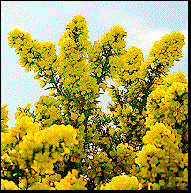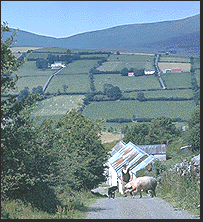 Sperrin
Mountains
Sperrin
Mountains
Official Site of the Northern Ireland Tourist Board
 Threaded
by streams and small roads, the Sperrins are bounded by the towns of
Strabane, Dungiven, Magherafelt and Newtownstewart. A section of the
gently contoured range spills south towards Omagh over the beautiful
Owenkillew river.
Threaded
by streams and small roads, the Sperrins are bounded by the towns of
Strabane, Dungiven, Magherafelt and Newtownstewart. A section of the
gently contoured range spills south towards Omagh over the beautiful
Owenkillew river.
Seamus Heaney, who writes incomparably about the mossy places of Ulster, grew up on the edge of the Sperrins. And it's true that in a mild winter the whin, or gorse, is in perpetual flower. The blossoms smell like sweet coconut. Boiling eggs in whin to dye them yellow is an Easter custom. Some farmers pound the prickles to feed to their horses - it's said to keep the coat glossy. Pigs like whin too. A good root in a whin bush is a pig's delight.
When the Four Citizens of London visited Ulster in 1609 their guide was under strict orders from the Lord Deputy of Ireland not to let them see the Sperrins. Officials feared that the mere sight of these inhospitable peaty hills would put them off. The Citizens were agents of the London companies who were cautiously exploring investment prospects in the area. The policy of settling large numbers of Scots and English loyal to the crown - called the 'plantation' of Ulster - needed money to succeed. Getting it out of the London companies required a certain amount of subterfuge.
 The
hills may be bare but there are fertile valleys lower down. The huge
oaks and elms of the primeval forest of Glenconkeyne north-west of Lough
Neagh delighted the new settlers. They chopped them all down and floated
the logs down the Bann to build Coleraine and Limavady.
The
hills may be bare but there are fertile valleys lower down. The huge
oaks and elms of the primeval forest of Glenconkeyne north-west of Lough
Neagh delighted the new settlers. They chopped them all down and floated
the logs down the Bann to build Coleraine and Limavady.
Until 1603 when Hugh O'Neill, Earl of Tyrone, submitted to the English at Mellifont, all the forested land west of Lough Neagh was Tyrone Country where O'Neill was a hunted outlaw. To avoid being murdered by his uncle which is what happened to his father - O'Neill had been sent to Sussex to be educated by Sir Henry Sydney. There he met Sir John Harington, who introduced the water closet to England, and also the Italian poet Ariosto. But this exposure to polite society did not deter O'Neill from fighting the English quite soon afterwards.
There are reminders of the green gaiety of the ancient wood around Springhill, a 17th-century fortified house near Moneymore. A thicket of old yews has survived and the lrish oak stairway came from local forests. Moneymore itself is a typical plantation town, with a market house, dispensary,and other fine buildings in the wide main street. Built by the Drapers Company, it was the first town in Ulster to have piped water.
If you are interested in the history of Ulster's linen industry, the private museum at Upperlands near Draperstown preserves original machinery. West of Moneymore at Wellbrook a beetling mill has been restored by the National Trust.
County Londonderry Overview | Exploring Derry | History of Derry | Sperrin Mountains
Northern Ireland Homepage | Travel Tips | Golf | Industrial Heritage | Walking, Hiking & Horseback | Activities | Calendar of Events | Transportation | Cuisine and Restaurants | Birdwatching | Fishing | Ancestral Heritage | County Antrim | County Armagh | City of Belfast | County Down | County Fermanagh | County Londonderry | County Tyrone | Tour Operators | InterKnowledge Home Page
Copyright (c) 1995-1997 interKnowledge Corp. All rights reserved.
